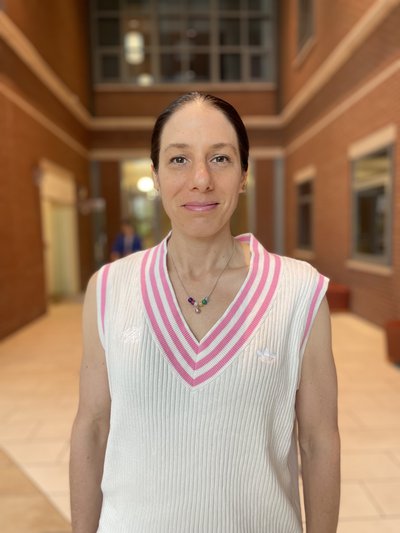Rachel C. Steinhardt

Rachel C. Steinhardt
Pronouns: She/Hers
Assistant Professor
CONTACT
Chemistry
3-008 Center for Science and Technology
Email: rcsteinh@syr.edu
Office: 315.443.2127
PROGRAM AFFILIATIONS
Biochemistry
Biotechnology
Degrees
B.S., 2005, University of California, Berkeley
M.S., 2010, University of California, Santa Cruz
Ph.D., 2015, University of California, Irvine
Postdoctoral Researcher, 2018, University of Chicago
Social/Academic Links
Courses Taught
CHE 600: Chemical Biology
CHE 414/614: Introduction to Medicinal Chemistry
Our lab has two main interests: chemical biology and soft polymeric materials. In chemical biology we are developing new neurobiological probes to study learning and memory and diseases like Parkinson’s and drug addiction. In soft polymeric materials we are developing new moving, force generating molecules for soft actuators in soft robots.
Organic Synthesis, Soft Materials, Medicinal Chemistry, Chemical Biology
Chemical Biology: We design and synthesize molecular probes which bind native dopamine and serotonin receptors, with a particular focus on DRD2, 5HT2A, and 5HT2C. We are interested in creating chemical tools to understand how these critical receptors contribute to learning, mental illness and addiction, and neurodegenerative disease.
Soft Materials: Our goal is to develop new tetherless soft actuators for soft robotics and mechanobiology. In our lab, we create the moving materials and incorporate them into soft robotic structures. We are especially interested in building strong, 3D structures that exhibit dynamic shape changes, or access multiple gait/movement methods.
Bioinspired Institute
Biomedical and Chemical Engineering
ACS Cottrell New Faculty Workshop, 2018
ASBMB Image Workshop, 2018
PMSE (Polymeric Materials: Science and Engineering Division) Session Co-Chair, ACS National Meeting, San Francisco, CA, 2017
UC Berkeley Undergraduate Research Apprenticeship Program Fellowship, 2003
Yao, Z.; Zhang, B. S.; Steinhardt, R. C.; Mills, J. H.; Prescher, J. A. Multicomponent bioluminescence imaging with an extended pi-luciferin. J. Am. Chem. Soc., 2020, 142, 14080. DOI: 10.1021/jacs.0c01064
Moser, B. A.; Escalante-Buendia, Y; Steinhardt, R. C.; Rosenberger, M. Cassaidy, B.; Naorem, N. Chon, A. C.; Nguyen, M.; Tran, N.; Esser-Kahn, A. P. Small Molecule NF-kB Inhibitors as Immune Potentiators for Enhancement of Vaccine Adjuvants. ChemRxiv https://doi.org/10.26434/chemrxiv.10043138.v1
Wu. M.; Moser, B. A.; Steeves, T. M.; Figueroa, A.; Wallace, B. M.; Kim, S. T.; Esser-Kahn, A. P.; Steinhardt, R. C. Photon upconversion for the enhancement of microfluidic photochemical synthesis. RSC Adv., 2019, 9, 26172–26175. https://doi.org/10.1039/C9RA03468D
Kimani, F.; Kim, S. -M.; Steinhardt, R. C.; Esser-Kahn, A. P. Correlating the Structure and Reactivity of a Contact Allergen, DNCB, and its Analogs to Sensitization Potential. Bioorg. Med. Chem. Lett., 2019, https://doi.org/10.1016/j.bmc.2019.05.017
Moser, B. A.; Steinhardt, R. C.; Escalante-Buendia, Y.; Bolt, D. A.; Barker, K. M.; Yoo, S.; McGonnigal, B. G.; Esser-Kahn, A. P. Immune potentietor for increased safety and improved protection of vaccines by NF-kB. bioRxiv DOI: https://doi.org/10.1101/489732
Tom, J. K.; Albin, T. J.; Manna, S.; Moser, B. A.; Steinhardt, R. C.; Esser-Kahn, A. P. Applications of Immunomodulatory Immune Synergies to Adjuvant Discovery and Vaccine Development. Trends Biotechnol., 2019, DOI:https://doi.org/10.1016/j.tibtech.2018.10.004
Brubaker, K., Garewal, A., Steinhardt, R.C. et al. Bio-inspired counter-current multiplier for enrichment of solutes. Nat Commun 9, 736 (2018). https://doi.org/10.1038/s41467-018-03052-y
Steinhardt, R. C.; Hiew, S.; Mohapatra, H.; Nguyen, D.; Oh, Z.; Truong, R.; Esser-Kahn, A. P. Cooperative CO2 binding by a bifunctional guanidine and bifunctional alcohol. ACS Cent. Sci. 2017, 3, 1271-1275. https://doi.org/10.1021/acscentsci.7b00418
Steinhardt, R. C.‡; Steeves, T. S.‡; Wallace, B. M.; Moser, B.; Fishman, D. A.; Esser-Kahn, A. P. Photothermal nanoparticle initiation enables radical polymerization and yields unique, uniform microfibers with broad spectrum light. 2017, ACS Appl. Mater. Interfaces 2017, 44, 39034-39039. https://doi.org/10.1021/acsami.7b12230
Steinhardt, R. C.; Rathbun, C. M.; McCutcheon, D. C.; Krull, B.; Porterfield, W. B.; Furche, F.; Prescher, J. A. Brominated luciferins are versatile bioluminescent probes. ChemBioChem 2017, 18, 96–100. https://doi.org/10.1002/cbic.201600564
Moser, B. A.; ‡ Steinhardt, R. C.‡; Esser-Kahn, A. P. Surface coating of nanoparticles reduces background inflammatory activity while increasing particle uptake and delivery. ACS Biomater. Sci. Eng. 2016, 3, 206–213. DOI: 10.1021/acsbiomaterials.6b00473 ‡ denotes equal contribution
Steinhardt, R. C.; O’Neill, J. A.; McCutcheon, D. C; Rathbun, C. M.; Prescher, J. A. Design and synthesis of an alkynyl luciferin analogue for bioluminescence imaging. Chem. Eur. J. 2016, 22, 3671–3675. doi: 10.1002/chem.201503944
McCutcheon, D. C.; Paley, M. A.; Steinhardt, R. C.; Prescher, J. A. Expedient synthesis of electronically-modified luciferins for bioluminescence imaging. J. Am. Chem. Soc. 2012, 134, 7604-7607. https://doi.org/10.1021/ja301493d
Hirschi, A.; Cecchini, M.; Steinhardt, R. C.; Schamber, M. R.; Dick, F. A.; Rubin, S. M. An overlapping kinase and phosphatase docking site regulates activity of the Retinoblastoma protein. Nature Struct. Mol. Biol. 2010, 17, 1051-1057. DOI: 10.1038/nsmb.1868
Halpenny, G. M.; Steinhardt, R. C.; Okialda, K. A.; Mascharak, P. K. Characterization of pHEMA-based hydrogels that exhibit light-induced bactericidal effect via release of NO. J. Mater. Sci. Mater. Med. 2009, 20, 2353-2360. DOI:10.1007/s10856-009-3795-0
Mizisin, A. P.; Steinhardt, R. C.; O’Brien, J. S.; Calcutt, N. A. TX14(A), a prosaposin-derived peptide, reverses established nerve disorders in streptozotocin-diabetic rats and prevents them in galactose-fed rats. J. Neuropath. Exp. Neurol. 2001, 60, 953-960. https://doi.org/10.1093/jnen/60.10.953
